Trying to rank a new affiliate site on google? Not sure, how to actually make google trust your new site? Learn the proven SEO strategies to monetize your new affiliate site from the very beginning.
That’s all about this master guide, and though you can’t actually take Google by the hand and force it to rank you highly – that’s exactly what you’ll learn here.
- How to build relevance with on-page SEO?
- How to create trust by getting good links?
- How to approach social media so it helps your site and does not become a time suck?
- Should you be conservative or aggressive with link building?
This, and so much more in this guide on Arfa’s awesome blog!

I won’t ask if you’re excited to read more; because I hate asking stupid questions. And because I know you are burning on the inside and simply yearning the read on.
So go on,
READ!
If you haven’t started a website yet, follow this comprehensive tutorial to start a blog today! Hundreds of bloggers have followed this step by step guide to launch their own blogs. You got to do it!
Quick navigation
The 3 components of a healthy SEO strategy to rank a new affiliate site
This is a guest post
When Google distrust a site, it deals with it by putting it in a box.
Now, this isn’t a literal sandbox, but a set of algorithms designed to suppress new sites from rising in the SEPR’s too fast, and taking up the real estate of those websites that are already proven as valuable.
This simply means that you could do perfect SEO and you still wouldn’t rank for a considerable amount of time, especially for anything with a strong buyer intent behind it.
“How long will this rankings drought last”?
That depends on you.
If you do everything wrong; if you scrape and spin content; if you build spammy links, you will never see the end of the tunnel.
But if you build out your site with longevity in mind, you’ll be pleasantly surprised at how fast Google can rank you.
These 3 components of a healthy SEO strategy are:
- Proper keyword research
- On page relevancy and site architecture
- Off-site authority buildup
Let’start with keyword research, as choosing a wrong keyword can nullify everything else you do;
While choosing the right one allows room for errors to be made and still getting the rank you want.
Affiliate Disclosure: This article contains affiliate links. If someone makes a purchase through affiliate links, I may earn a small compensation. For more, please read on to privacy policy and disclosure.
1- Proper keyword research
“Proper” in this context signifies long-tail keyword research.
You see, new affiliate sites need to target long-tail phrases because that’s what they’re realistically capable of ranking for.
And what’s neat is that long-tail keywords have much clearer user intent behind them. And they’re often buyer keywords to boot.
Rank for a few of those and it won’t be long before you make your first sale.
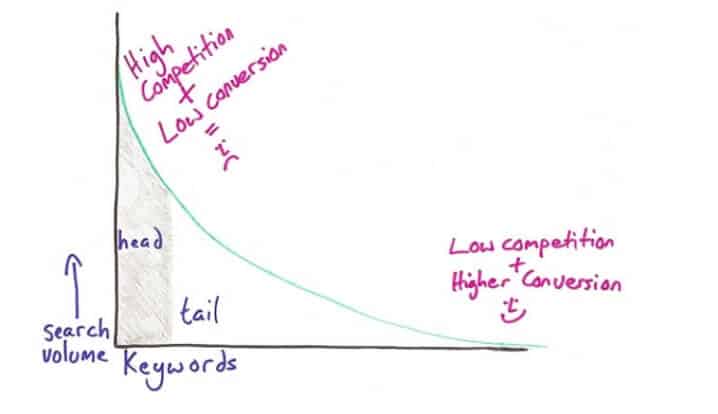
For example, what’s the search intent behind this key-phrase: “Where can I purchase KWFinder tool with a discount”?
In my humble opinion, this person already knows about KWFinder.
They’ve heard it’s an awesome tool; they need a keyword tool for their affiliate site, and they just want to check up on a few things before they buy.
Well, in that case, you’d want to be racing for this long-tail phrase that gets only a few searches per month. That is because each searcher is a likely buyer.
Note: I know Arfa loves KWFinder and uses it all the time. She even wrote an awesome review that you need to check out pronto, especially if you’re on a hunt for a new keyword tool.
On a side note- why is it important to rank as quickly as possible?
Before we get into keyword research proper I want to quickly explain why it’s crucial for a new affiliate website to rank for at least some phrases as fast as possible.
It’s because of traffic, but not in the usual sense.
In the beginning, you won’t be getting big enough traffic to make sales, but you will be getting big enough traffic for Google to see how people behave on your site.
This is very important because, to Google- UX is everything. And if they can see that people like your site and stay on it, they’re going to push you higher and faster.
The UX signals to pay attention to are:
a) Pogo sticking
Do people click through to your site and then leave in 5s or less? That’s pogo-sticking a and it’s a terrible signal to be sending to Google.
Fix it quickly or be gone!
b) Bounce rate
Do people stay on your page, read, and then leave without exploring further?
That’s not necessarily bad for SEO, but you still want to keep people for as long as possible.
Because people who stay are people who buy and subscribe.
You need a better internal linking strategy.
c) Dwell time
Is your writing compelling enough so people stay for 1m or more? If not, make it so because people sticking around is a ranking boost for you waiting to happen.
Bottom line
Do your best to get those few initial visitors onto your site. Once Google realizes that your site gives people what they want, they will want to promote and rank you higher.
Remember, Google needs a quality site to thrive with THEIR business.
How to do Keyword Research for a Brand New Affiliate Site?
Going the long tail model is key, and here are three simple ways to do it.
#1- Alphabet soup technique
Have you ever noticed how Google likes to show search queries in your face? Search for THIS! Search for THAT!
THIS is what you really want!
It has a name- Google Suggest and it’s very annoying, in my opinion. But it’s also very useful for keyword research.
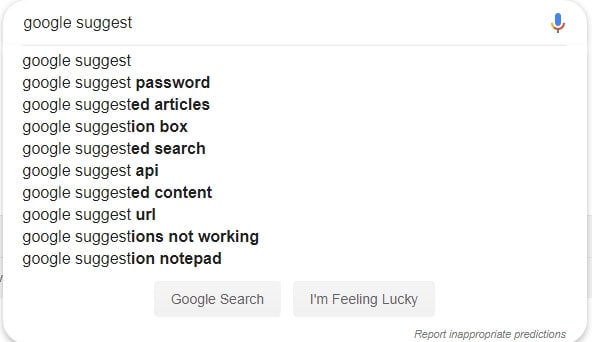
The problem?
Google has limited space so they only show you popular phrases.
The downside to this is that lots of people compete for these popular phrases, and also, you don’t know the monthly search volume for the keywords you’re targeting.
The answer to these problems is to use KW research tools, and I have two for you below.
#1- Jaaxy
Jaaxy is a freemium keyword tool that mines long tail key-phrases no other tools shows you. And it also shows you your exact competition, i.e., the number of sites that intentionally target that phrase.
It a tool built for affiliate marketers because it tells you the only two metrics you really need to be successful in any niche.
The cons are that Jaaxy Starter (free account) only allows for 30 searches per month, which is not enough for full-blown camping.
#2- KWFinder
As mentioned before, KWFinder is awesome and is quickly becoming my favorite keyword research tool.
Its design is clear, simple and elegant. And the interface is so intuitive that even a baby could figure it out. And most importantly- the data KWFinder spits out is highly actionable and reliable.
The best part?
The free version of KW Finder is going to serve you well if you’re an on a tight budget. So go on and sign up for your free account. I’ll wait.
If you are still looking for an affordable keyword then make sure to check out Keysearch! It’s a growing keyword research tool with amazing features. I highly recommend it!
Back? Good!
For the next part of the article is where you’ll learn proper on-page tactic and hacks.
I have chosen the keyword “How to make Turkish coffee”.
Why this one?
For two reasons:
First– I love Turkish coffee. I love to drink it and it’s a pleasure writing about it. The beverage is robust, invigorating and can be blended with spices, aka Moroccan style.
Second– Both Jaaxy and KWFinder show it’s as an easy keyword to rank for.
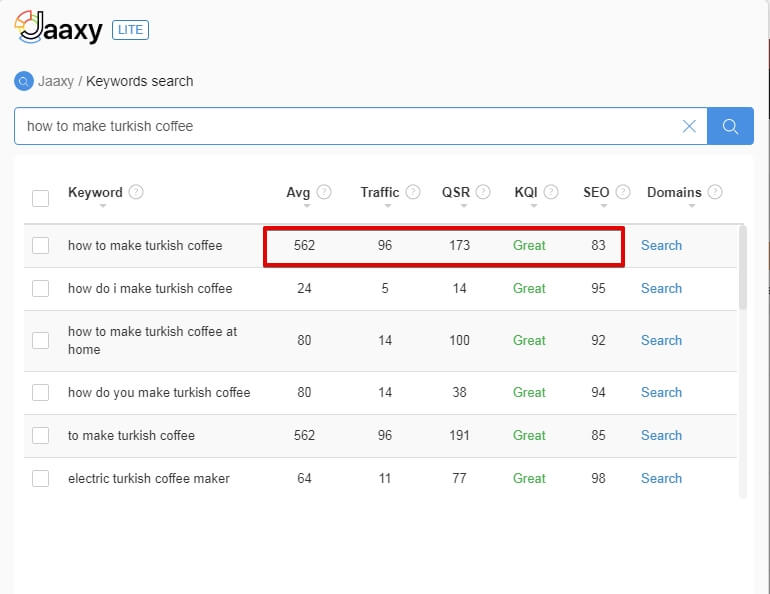
And, in kwfinder.
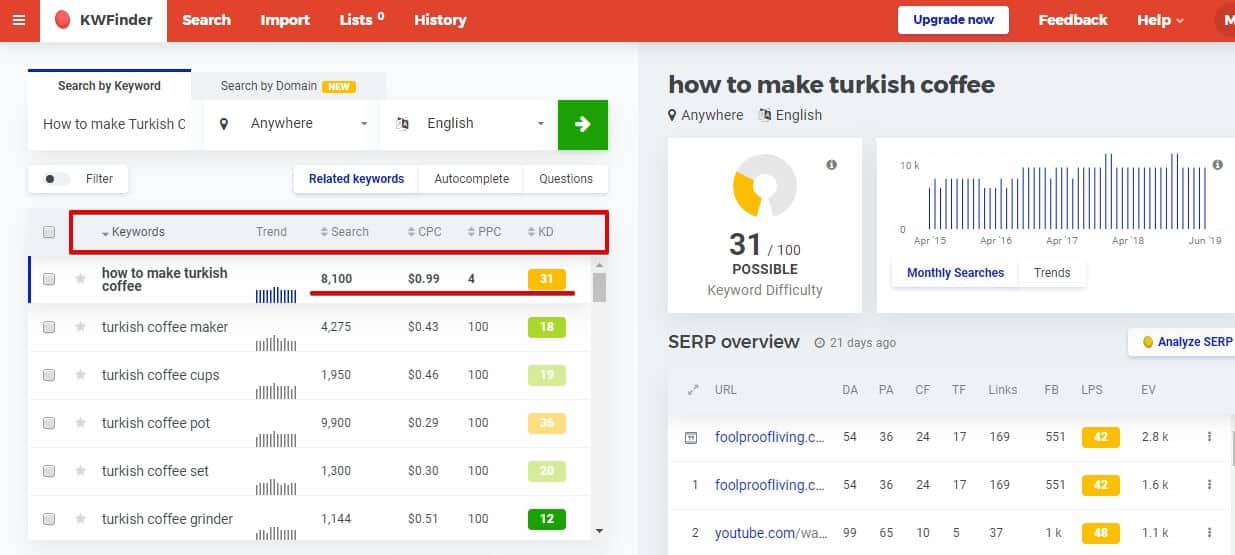
Third– it’ll be easy to tie in a promotion of some brand of Turkish coffee. So you can convert visitors from this informational type keyword.
Suggested: Want to get started with affiliate marketing? Here’s the beginner guide to affiliate marketing for bloggers.
2- How to SEO an article so it ranks quicker- On page relevancy boosters
Note: These are the things you can do today on your site to improve its rank quickly.
Meaning, on-page SEO is the crucial first step you must take to bring yourself as high as possible while at the same time cutting the need for link juice you’ll need to get to the top.
And making your site ultra search engine friendly is actually divided into 2 distinct parts
- On-page SEO (boosting article relevance)
- On-Site SEO- (site architecture and Page Rank flow)
On-page SEO – how to build relevance through strategic keyword placements.
I’ll show you the exact way how I optimize every article on my site before hitting publish, and I’ll use our example keyword from above “how to make Turkish coffee”
Let’s go!
a) Exact match keyword in the SEO title
The SEO title is the second most important on-page ranking factor for Google (the first, of course, is content In case you were wondering…).
It’s a prime real estate for you to tell Google-bot “hey Google! My article is about THIS keyword. Rank it for it, RIGHT NOW!
Pretty please:)”
Here’s how I’d do it:
How to make Turkish coffee at home- a simple guide
b) Keyword in the URL
URL is another high level, powerful hint on what your page is about.
Have the keyword you’re targeting in your URL.
Like this: https://blogname.com/how-to-make-turkish-coffee
Pro tip: If your keyword is very long, use just it and nothing else. You don’t want your URL to be too long, because then it’d look kinda spammy. If it’s a bit shorter, don’t be afraid to use some filler words too.
For example: learn-how-to-make-turkish-coffee-at-home
c) Meta Descriptions
Meta d. don’t help with Google ranking directly. But they do help with boosting relevancy. So have your keyword in there for good measure.
Example of meta description: Make Turkish coffee at home and explode your taste buds to pure bliss. You won’t regret it… unless you don’t click on this page. Then you’re doomed to live a tasteless life.
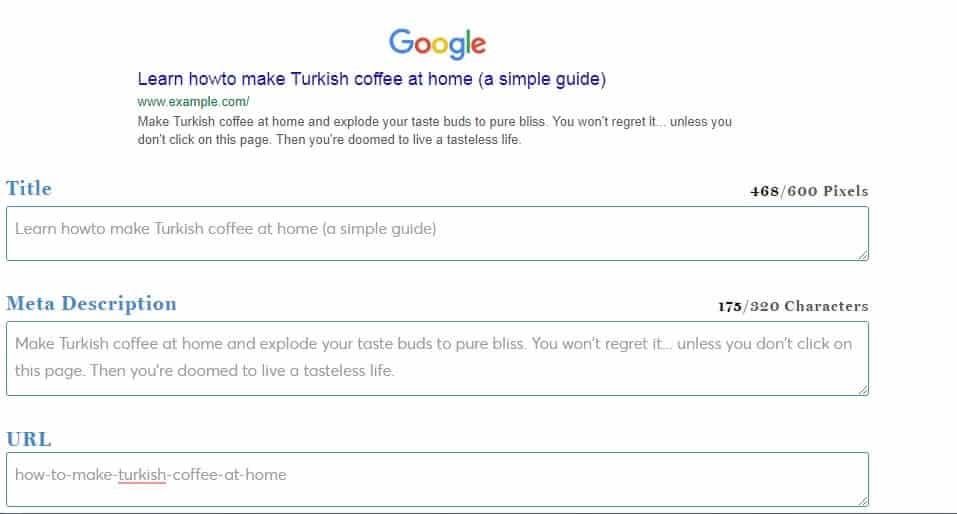
d) keyword in the H1 tag
If you read a lot of copy-writing stuff, for example, CopyBlogger.com, you will find advice that your headline has to be catchy and compelling enough for people to continue reading, once they’re on the page.
That is true. What’s not true is that you need to completely eschew SEO in favor of being clever with your words.
The best SEO’s in the world use SEO copywriting and to their great advantage over everyone else.
But I’m here to tell you that even if you’re a newbie it pays to spend some time and think of a headline that’s both:
- human eyes-friendly
- AND has your target keyword in there.
Trust me– it is worth it and your readers will love it because they will see they’ve landed on the right page.
For example, here’s my take on it
Wanna make truly GREAT Turkish coffee at home? Well, you need to know how, so you need to read this guide, NOW!
That headline has my target keyword in it, and by using the word “great” I’ve caused a mini adrenaline flood in the brains of those lucky enough to read my words.
They will continue reading for sure…
They have no choice now:)
e) Keyword in the first 100 words
This is an old SEO hack that is no longer a hack but still works very well.
Keyword in the first 100 words tells Google ” Hey Google! Like I was saying, my article is about THIS keyword”.
f) Keyword in the content body
I should have said keywords, plural. You want to have your keyword at least 3 times in the content body: Once in the:
- beginning- first paragraph
- middle
- end- conclusion
If you can do more and make it read natural- go for it. Otherwise- don’t sweat it. Google is smart enough and keeps getting smarter.
g) Keyword in one of the “lower subheader”
I’ll be honest with you: Subheaders are not that important for SEO. You don’t have to have an exact match keyword in your subheading in order to rank well.
But if you can manage it, go for it because it’s an easy way to boost article relevancy, and ultimately, rankings.
But, again, the effect is really small.
I usually do that at every end.
For example:
Conclusion: do you know know how to make Turkish coffee at home?
h) Image SEO
Each post you write is bound to have images in it.
Right?
They spruce up your content quite a bit and make dull words come alive with color.
Images are great and all-but don’t forget about SEO-ing them. Image SEO can help you rank in Google Images, but they also boost your article’s relevancy so you rank higher in the normal search.
Bottom line
Your first image should have your exact match keyword in:
- alt attribute
- keyword filename
What’s neat is that these are only found in the source code so it won’t feel jarring to the actual visitor reading the page.
i) TF-IDF
TF-IDF stands for Term Frequency- Inverse Document Frequency and it’s basically a way for you to find words and phrases your competitors are using, but you’re not.
So, by sprinkling them within your article, you can boost your content’s relevancy score and thus become more relevant (hint: you’ll rank higher)
That’s the theory behind TF-IDF.
Unfortunately- it’s just that-a theory.
In practice, Google has moved beyond TF-IDF and now it might be a pure waste of your time doing it.
Why?
It’s because, when you use a TF-IDF tool it scans the first page of Google and gives you word usage recommendations.
Add this keyword X times; remove that keyword Y times…
that’s nice and all, but Google determines its relevancy score by scanning the entire web, or at least it’s gigantic index.
That’s incomparable with what the TF-IDF tools are doing and that’s why I don’t recommend it anymore.
Note: Click on the image below to read what Bill Slawski thinks about TF-IDF. He’s been doing SEO since 1994, so he knows what he’s talking about.
And he’s thoughts are what turned me against TF-IDF.
Bottom line:
Don’t do TF-IDF optimization. Especially since it takes too long to do it and it’d be a time waste to do it for every single article.
Just for a minute. Please pin the image below and continue reading the posts.
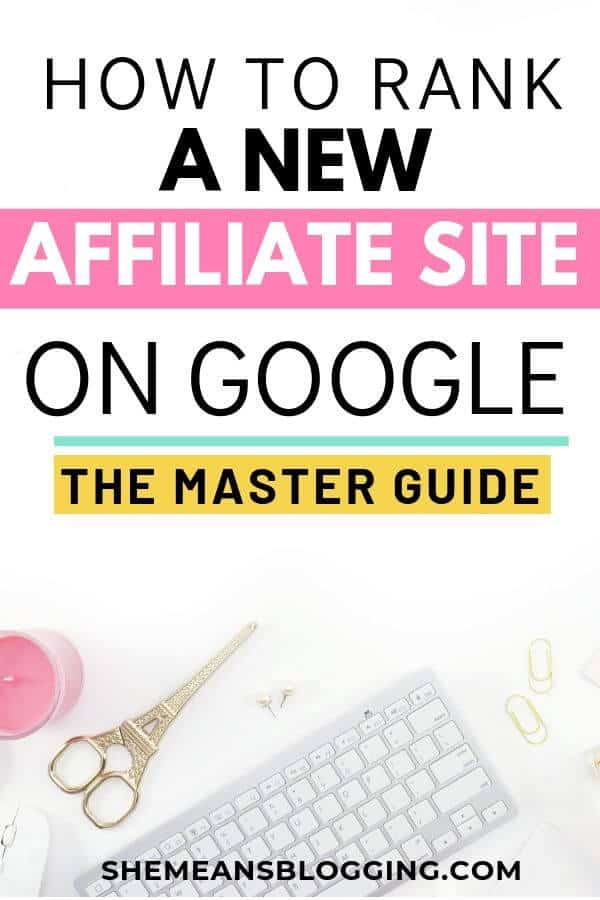
j) External linking
Outbound links are good for SEO. Pages that link out liberally outrank those that don’t, but at the same time relevant outbound link boost your pages relevancy scores which means easier ranking in general.
So, with our target keyword “how to make Turkish coffee”
I’d link to guides about Turkish coffee and Turkish coffee recipes.
easy peasy:)
k) Internal links
Ah, internal links.
I LOVE them!
So very much because they remind me of backlinks, yet are so easy to do and set up that it is mind-boggling for me to fathom why so may sites do them wrong, or not do them at all.
But that’s good news for you because you can get a huge head start ahead of your competition.
Recommendation: On-Page SEO is what you need to make your content rank on Google. From titles to internal links, all of the must-follow seo practices are included in this affordable ebook. Check out Easy On-Page SEO
Internal linking tips
First- use keywords. Every internal link should be keyword-rich, and every internal link that doesn’t target a keyword is wasted potential. You can learn more about adding internal links in this post.
Second-use them to funnel authority around your site… More on that in a second, but here are some easy to follow anchor text guidelines:
- exact match anchors- 50%. This is your keyword repeated in verbatim.
- Partial match anchor 30%. This is your keyword and some filler words
- naked URL- 20%. This is just your URL with nothing else.
There is no Penguin penalty for internal link building, but it is still possible to over-optimize internal linking anchor text ratios.
Follow these guidelines and you’ll be both safe and effective;
like a ninja:)
Site architecture – How to structure your affiliate site to facilitate rankings
Site structure is a branch of SEO I see many shirts away from. I don’t know why.
First, it is insanely important to do. Proper site architecture allows you to rank with the least amount of links possible.
And doing it wrong is the equivalent of shooting yourself in both of your legs.
Second, it’s really easy to set it up. You just need to set aside an hour of your time and think what you want your site to look like.
Here are some tips to get you going:
#1- Your site needs to be shallow
This means that any article should be reachable from the homepage in 3 clicks or less.
This is important because a site’s homepage is almost always a Page Rank hub and most authoritative of the bunch; so closer something is to the home page the more important it is in the eyes of Google.
Note: with each click depth, 15% of PR dissipates.
For example, Arfa has here site wonderfully set up.
Look, from her homepage you can access her most important pages. And if you hover over the “Blog” tab, you can see that it expand into her blog’s categories.
Click on the category (#1 click) and you’re presented with all posts from that category. Click on the post (#2- click) and start reading.

Her site is shallow and all her content is accessible with the minimum amount of clicks. So, she is using her link equity very well and I’m sure it shows in Google.
#2- Build your content with pillar/cluster model
This is a model that takes heavy advantage of Google using semantics to sort out their SERPS.
Namely, by building out your content in a hub + cluster way, you’re sending out a strong message to the search giant that you want to be ranked not just for one keyword, or two keywords, or three…
but for an entire umbrella topic which covers thousands of keywords.
Here’s how to do it.
What is a topic hub AKA pillar content?
A pillar page is your main page about a topic, targeting the main, short tail, head keyword.
For example, let’s say you wanted to rank for the term “Affiliate marketing”.
Then you’ll have to make some sort of an ultimate guide to affiliate marketing.
But then you’d have to write a dozen or more articles all targeting longtail keywords and under the affiliate marketing umbrella.
For example, you’d have:
- How to avoid affiliate marketing scams
- How to cloak affiliate links
- Is affiliate marketing worth the effort
- Can I do affiliate marketing without a website
- Is affiliate marketing legitimate
- How much money can I earn with affiliate marketing
- Does Google hate affiliate websites
- Affiliate marketing successful example websites
- Is affiliate marketing the same as MLM
- How long till I make my first sale with affiliate marketing
And all these articles would expand on one facet of affiliate marketing, while simultaneously mentioning the main affiliate marketing guide you’re aiming to rank.
Here’s an illustration from Arfa’s blog post about proper content clustering.
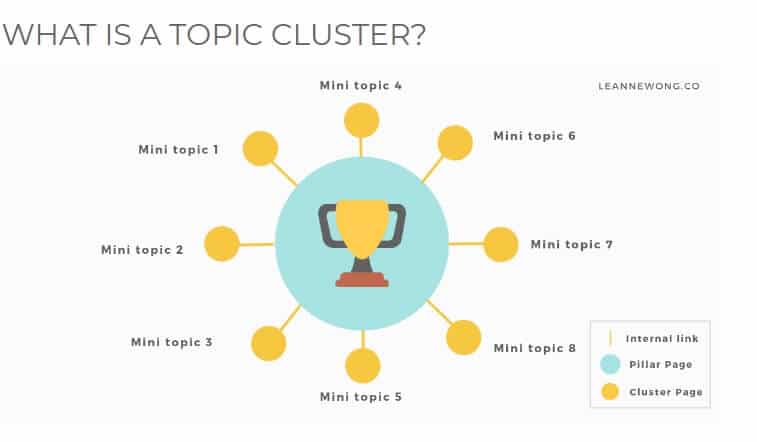
And now I want to quickly show you how to interlink these babes for maximum effect and I mean MAXIMUM.
Common wisdom about content clustering says that your pillar page needs to link to the entire content cluster, and supporting article each in turn link to the pillar page.
And that is true. You should do that.
But I like to take it a step further and have each supporting article link to every other in the set.
So, in our case, one article would link to its:
- 9 other siblings,
- parent (affiliate marketing pillar page)
- grandfather (tag page)
- great-grandfather (category page)
And this would be repeated across the entire set of 11 articles (pillar page + 10 supporting articles).
It’s a great hack interlinking like this, but the downside to this is that you need to have a reasonable number of supporting articles. For example, if you have 10, then you can interlink them just fine, and it won’t look stuffed with links.
But if you have 50 articles, then it won’t work, because you can’t have 50 internal links, + external links in one article.
That is bad UX.
How about an example from my site?
Therein I have written a 12000-word review of the Wealthy Affiliate Program.
Well, that review is my pillar page.
And I have 5 supporting articles linking to it, with one more in draft mode and approaching fast.
Here’s how I interlinked my pillar/cluster hub for maximum relevancy and SEO juice:
- All supporting content links to the pillar page
- Pillar page links to each supporting article
- All content (pillar + 5 cluster article) link to taxonomy pages (tags and archives)
- Taxonomie pages link to all 6 article in the set
This model works very well for my tiny site.
I know because I have my WA review ranking for dozens of high volume keywords in the middle of page two in Google.
That’s not page one where all traffic is at, but I know that day is approaching fast. I see daily improvement now and I will continue to work on it.
When it comes to writing a blog post, you can actually choose different content formats and experiment. This post shows more than 17 different types of blog posts to write.
Hint: now that I have my relevancy established, it’s time to focus on boosting my site’s authority.
Make sure to pin the image below so that you keep coming to this post later.

3- Off-page SEO- it’s not just link building you know
Off-page SEO is far more important than on-page when you’re building trust with Google.
The reason for it is that while on-page depends on what you do; of-page is what others think of you and that is harder to manipulate in any substantial, sustained way.
At least in theory 🙂
Off-page SEO for a new affiliate site can be divided into being social and building links AKA blogger connections.
Since social is easier and can be done quicker- we’ll start with that.
1- What are the best media channel for promoting a newly sprung affiliate site?
“The best” is totally depending on your chosen niche.
Are you a professional photographer traveling the world taking stunning pictures? Then Instagram is your best chance to shine through obscurity.
Are you an affiliate marketer? Then go and join Facebook groups to get in touch with other bloggers and their audience.
Are you an SEO looking to connect and expand their network? Then go hit up Twitter.
Ok, that was super brief, lets flesh it out a bit.
a) Facebook
Facebook is great for online business because you can connect with your fellow bloggers. You can do this by joining different Facebook groups.
What is really neat is that these groups consist of people on the same path as you and often in the same position as you.
- No money
- no sales
- no business
But a strong desire to have one.
So why not unite and help each outer out?
Arfa has a facebook group too where she welcomes new and growing bloggers. Her community has more female bloggers but it’s always connecting with bloggers around the globe. Click here to join her facebook group.
A share here, a link there. A mention over there. Over time it builds up for true SEO gain, but what’s more important is that you get valuable blogger friends that can help further down the line.
Through FB Groups, you can build stable business connections; because, in online marketing, it’s now what you know, but who you know that counts the most and within those Facebook groups you can meet a tonne of great folks.
For example:
I’m in the SEO space and a wonderful group for me would be BloggersPasisonVIP led by Anil Agarwal. It’s chock full with newbies and advanced bloggers I can easily connect with.
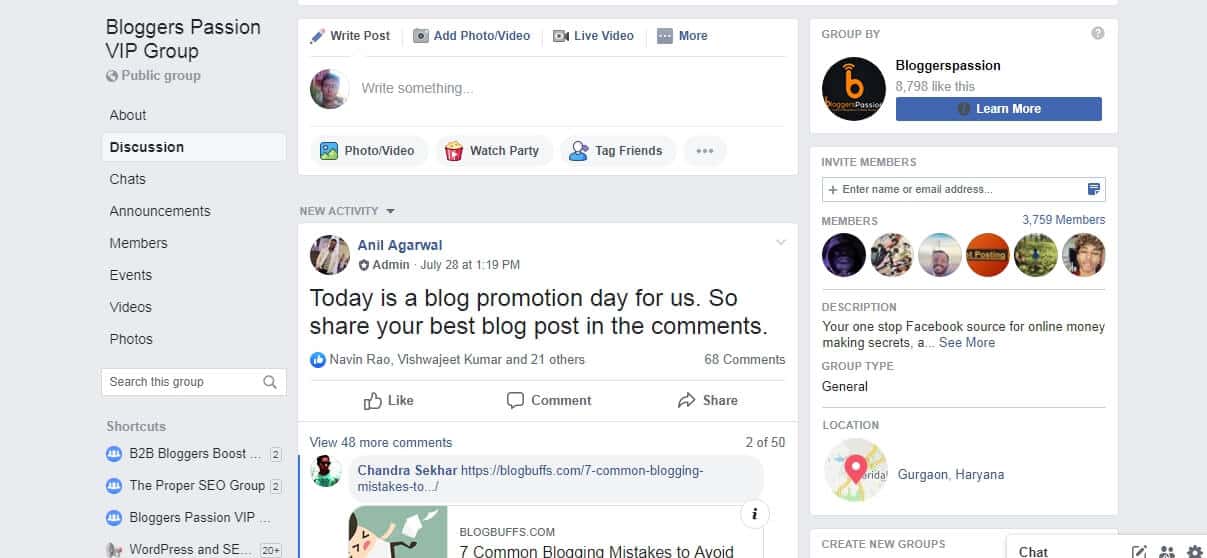
b) Twitter
I’ll be honest with you.
I used to hate Twitter.
Why? It’s because I read that the average tweet has a shelf life of approximately 7m and I thought that I shouldn’t bother with such a worthless platform.
Oh, boy! How wrong was I!?
While it’s true that most of my tweets of my own content don’t bring me any traffic, me tweeting someone else’s work does make a positive ripple for me.
I mean, whenever I promote other people’s work, they get notified in their Twitter dashboard. For example, here’s a notification I got. Arfa was kind enough to share one of my articles.
Thank you, Arfa that did not go unnoticed.
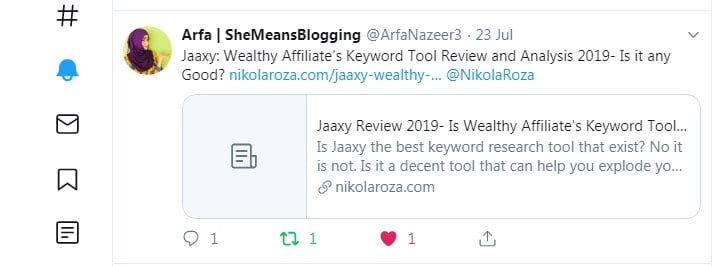
you get it?
Twitter is a perfect tool for connecting with folks and I regret that I didn’t start tweeting sooner. Here’s how you can start writing engaging tweets on twitter.
c) Pinterest
Pinterest is an image-based search engine that’s sort of opposite to Twitter. What I mean is, that while tweets have a short shelf life, pins have a nearly indefinite shelf life.
So one good Pin can bring you traffic for years to come.
How to approach Pinterest for maximum results?
Strategically. That’s the answer.
Due to Printers being a lot more stable, akin to a search engine, and due to them gratuitously sending boatloads of traffic to external websites, more and more people have caught on and it’s become crowded in there too, similar to Google’s SERPs.
I mean it is easy to understand why.
You can earn serious money from Pinterest traffic alone. Heck, Ling Tran from Finsavvy Panda is making over $10 000 from Pinterest, month over month.
All this means your pins will have to stand out or they will get drowned in the noise.
My advice – Invest in a Pinterest course! If you are completely new or maybe, using pinterest for a while, I do recommend this ‘Pinterest Course’. Ell knows Pinterest marketing really well! Her course is so affordable that you don’t have to think for a second.
Also, invest in a tool, I recommend Tailwind.
- Suggested resource: How Does Pinterest Work? Your Ultimate Guide to Using Pinterest
Below is Arfa’s profile on Pinterest where she gets more than 1.2million monthly impressions.
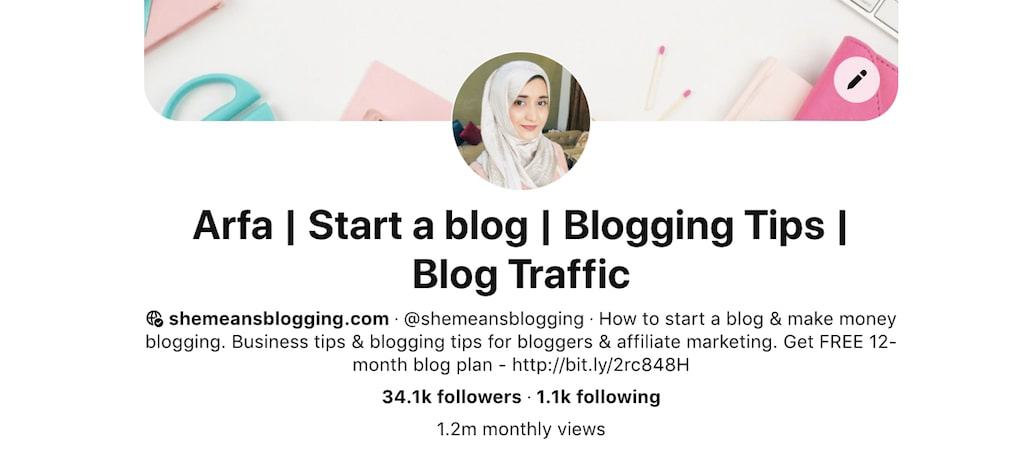
d) Instagram
Instagram is blowing up right now. There are over 1 billion monthly users and that number is still going up fast.
It seems like everyone I know is having and using their accounts.
And… I admit I don’t get it.
Maybe it’s because I’m pretty shy and don’t like splashing picture of myself so everyone can watch me?
No, I like me my privacy a bit more.
Or maybe it’s because I’m in the SEO space which isn’t sexy by any stretch of the word; so I can’t be using it for business.
But if you’re in one of the following niches
- Travel
- Celebs
- Lifestyle
- Business (you can post quotes)
- Animals
- Beauty
- Relationships
Go for it. It will probably do you good. Or, you can also use all of these creative instagram post ideas.
In fact, it might blow other channels out of the water.
Two other ways you can use Instagram
I thought about this a lot. It really bugged me that there was such a popular channel with seemingly no way for me to get involved for the benefit of my business.
That’s when it downed to me.
a) You don’t have to use Instagram strictly for business. Instead, you can use it to show your human side.
For example: Kyle and Carson, the guys being Wealthy Affiliate program I mentioned earlier, use Instagram to show off they’re just regular folks with nice families behind them.
Here’s Kyle’s account full with pictures of him, his wife and children.

I like that. I really do.
And I know that f I was someone interested in joining WA, but still hesitant, these images would’ve melted my heart.
I’d know there are real human beings behind the operation and they’re not afraid of showing their faces.
Because they’re LEGIT.
b) Use Instagram to show off the life made possible by affiliate marketing.
So you have an affiliate site and it is making you some dough. Some serious dough in fact, as you’re earning more than you thought possible.
The best way to invest that money is to travel and experience new things, because you’re only as rich as how rich of a life you’ve had.
So go hit up the most beautiful place in the world and then make sure you post those images on Instagram.
It’ll be good for business too, because it’ll be a subtle message on how affiliate marketing changed your life for the better.
For example: I really like what Ryan Biddulph is doing. He’s Instagram profile is chock full with beautiful imagery he takes while traveling the world. I think he probably circled the globe 10 times already and is not stopping any time soon. Because he enjoys it so much.
And I can understand why. You’re reading the words of a future but soon to be, world traveler.
And Ryan’s photos are an inspiration to me.
What about you?
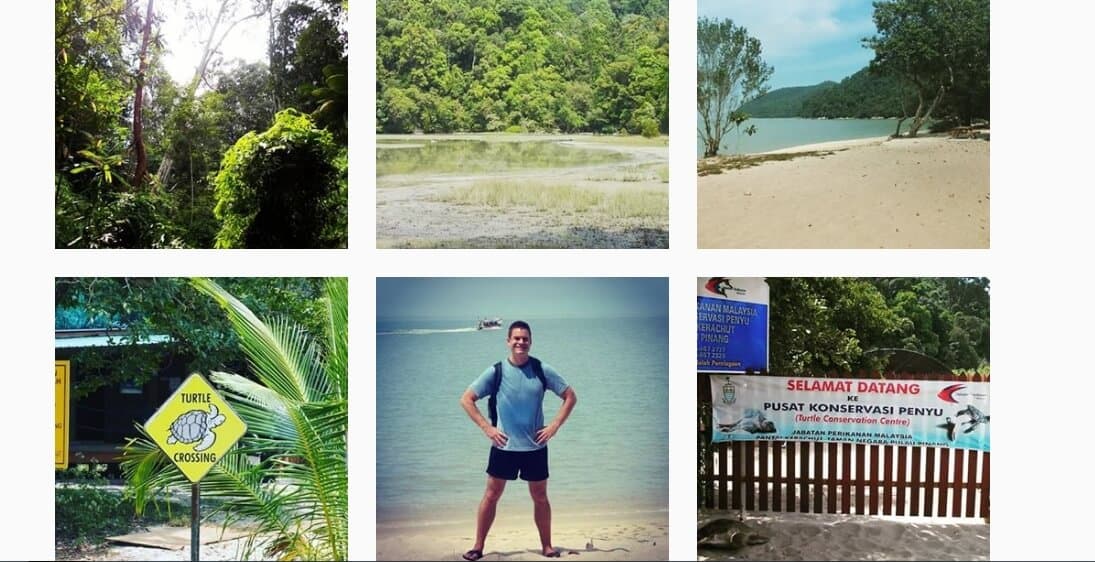
Instagram tool. Do I need any?
Hm, probably not in the beginning. Just try it out and see if it gels with you. If it does, then you can consider being a pro and investing in a tool that will bring you returns many times over.
2- White Hat links that yield result (beginner-friendly too)
Ok, links are where we at and boy is this a lengthy topic.
So, lengthy in fact that I won’t begin to pretend I’ll cover it all here.
Instead, I will tell you about a few easy stratagems that won’t take up to much of your time, but will still yield magnificent white links no Googler can frown upon, ever.
Here are the tactics; Enjoy!
a) Guest posting
Boring I know.
But hear me out, because it works.
Guest posting is when you write an article or several articles for another webmaster, and they post it on their site, with links pointing to your site.
This link building tactic is probably the easiest one to get into because it is 100% based on exchanging value. You give them awesome content chock-full of keywords to post on their site;
while they vouch for you by linking to you.
It’s a win-win situation
How to find guest posting opportunities?
Try these search strings:
- “Niche” + guest post
- “Your niche” + contribute
- “Your Keyword “guest blogger”
- Your Keyword “looking for guest posts”
- Your Keyword “accepting guest posts”
- Your Keyword “articles wanted”
- Your Keyword “contribute to our site”
And in Arfa’s case “Guest Post“
This will open up a bunch of possibilities.
Then you just need to gather these sites in a nifty little spreadsheet.
Here’s one I made just for this post to show you how it’s done:
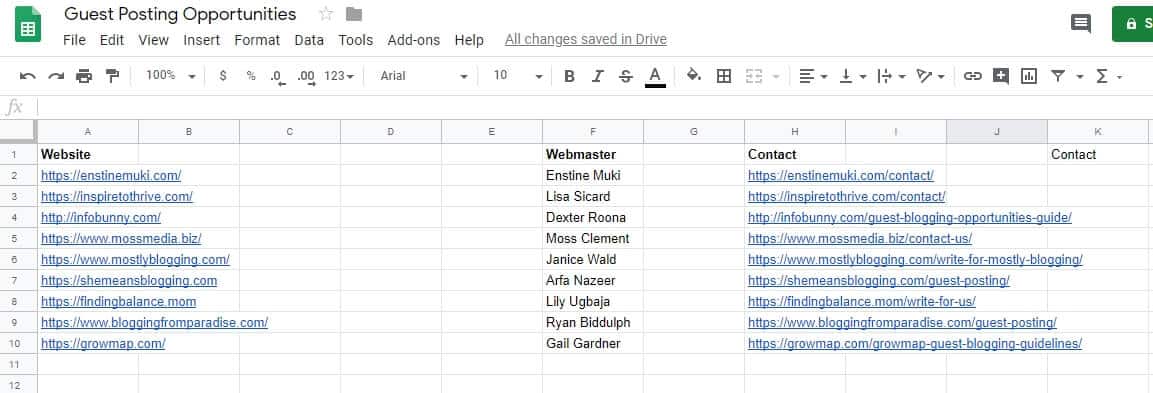
Pro tips
When a website openly advertises they accept guest contributors, that means it’ll take very little to convince them.
But don’t let that “little” turn into way too much for you.
In other words: don’t send them an email right away.
Instead, spend some time to get on their radar.
- Share their stuff on twitter,
- comment on their posts,
- link to them and let them you’re funneling precious link juice their way
Use everything you have in your arsenal to establish yourself as a blogger willing to help others.
And THEN send them a pitch, which in my experience has a 100% success rate.
Neat, no?
Bonus tip: Sometimes, (not always) the site will have a contributors page, where all its contributors are proudly displayed.
For example, here’s me on Lisa Sicard’s awesome blog:
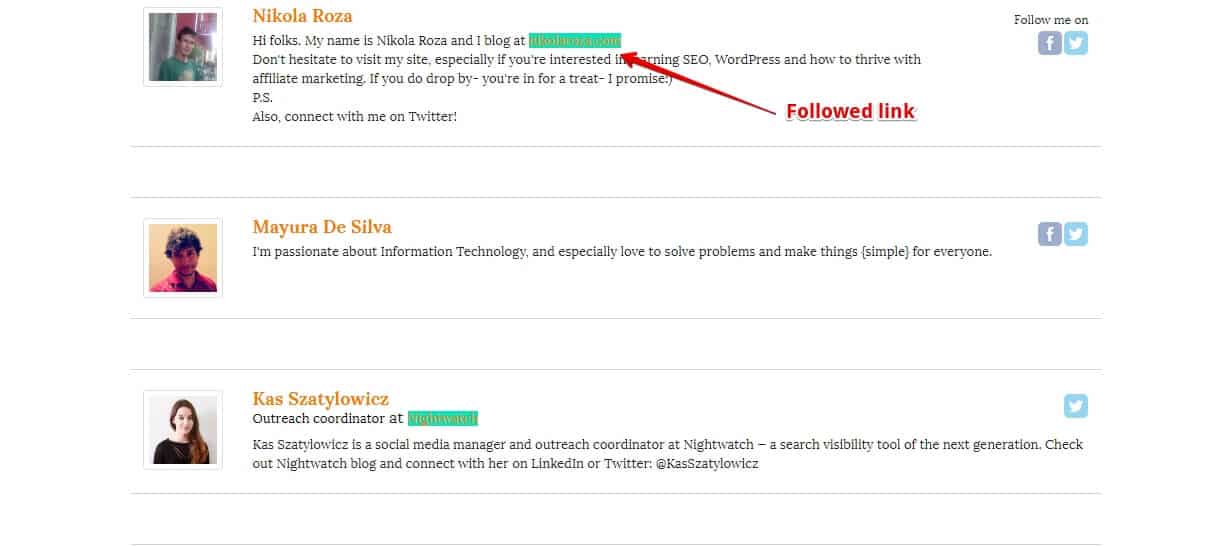
I like this link a lot too because Lisa’s contributor’s page is the menu of Inspire to Thrive, which means that every other page on her site links to it.
And since here site has 806 indexed pages in Google (I checked) then that more than 800 internal links pointing to that page that host my link.
That’s A LOT of link juice flowing to that page and then to my site.
I admit it – I was thrilled when I got that awesome link 🙂
Suggested post: 12 free ways to build quality backlinks to your blog.
b) – Interviews
Interviews are a double hit for you.
Not only can you score some beautiful links with nice anchor text to boot but you also get introduced to a whole new audience that probably never heard of your before.
And don’t forget that Google’s algorithm is constantly learning, and when they see you getting interviewed, and a lot, it will consider you a brand. And brands are boosted like crazy in Google SERPS because according to them.
Brands are the solution, not the problem… Brands are how you sort out the cesspool.
Now, how about some awesome examples?
Here’s an interview of mine I did with my buddy Vince Comfort. It was my first one and I’m really grateful to Vince for inviting me at the time I was just a blogging nobody.
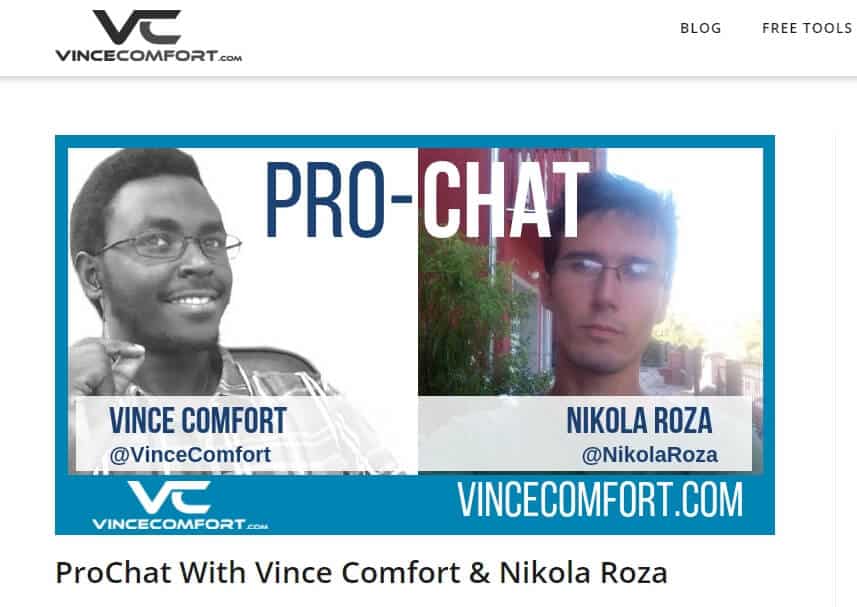
And here’s an interview my hostess Arfa did with Nadalie Bardo from It’s All You Boo
Great stuff!

First time I read it and I’m glad I did.
I got to learn how Arfa handles her business with ample professionalism and how she manages to get everything done while still keeping a life-work balance.
I can learn a lot from her, cause I’m a mess:)
Note: Arfa also has her interview series. Check it out when you have the time!
c)- Link roundups
In every niche under the sun, the moon and the stars, roundups abound. These are weekly, monthly posts that gather links to other awesome resources published that week or month.
It’s cherry pickings getting into one of those. however…
Pro tip: Remember I said “awesome content”. That means that your 3 tips to do “this”, or 2 ways to do “that” won’t cut it. Bring awesomeness to the table.
How to find link roundups?
Here are some search queries for you:
- “Keyword” + best posts of the week
- “Keyword” + “link roundup”
- “Keyword” + intitle:roundup
- “Keyword” + inurl:roundup”
- “Keyword” + best blogs of the week
- “Keyword” + “weekly link”
- “Keyword” + “weekly roundup”
Pro tip Alternative to link roundups are blogger roundups. A blogger, for example Lily Ugbaja send emails to fellow webmasters asking them to contribute to her “should you quit blogging” roundup.
Bloggers respond and in turn, get a sweet backlink to their homepage.
Here’s Arfa’s response about the moment when she almost quit but didn’t.
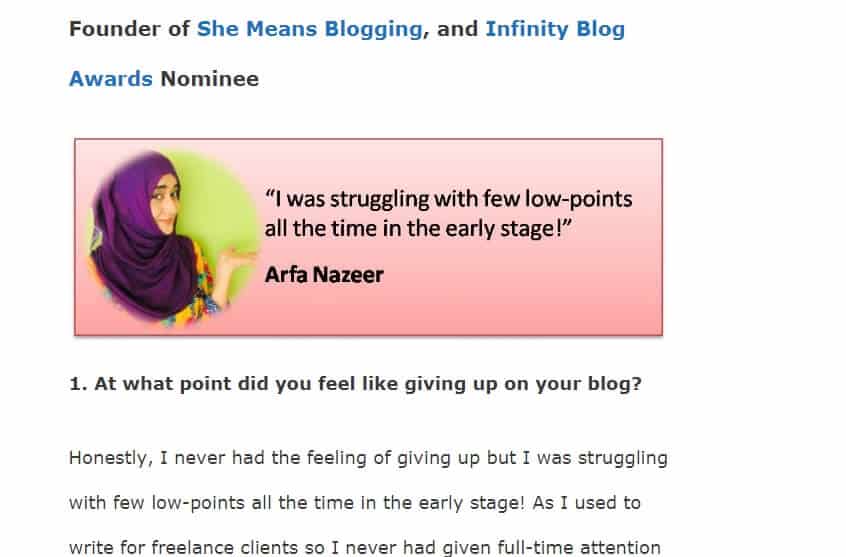
Bonus #1- which links are better- to the home page or the page you’re trying to rank?
Both types of links are valuable but in your situation when trying to rank for affiliate phrases, the later is a bit more effective.
You see, homepage links boost your site’s authority so you rank higher for everything in general;
while links pointing directly to the page help you more because they flow PR directly to that page and they also carry nice anchor text with it. But both link types help and you should welcome any good link that comes your way.
Bonus #2- what is the right link velocity for new affiliate sites?
Link velocity is a term made-up by nerdy SEO. It tries to guess/measure the ideal pace your inbound links should come in so as not to trigger the Penguin algorithm.
And…there is no right or wrong answers.
It’s all niche dependent and but also query dependent.
However, in general, if your site is really small, like you only have 5 posts or so you will need to start really slow. First link here, second link there, third over there. Then make a break and repeat…
But also mix up the pages that are getting links and also send half the links to homepage…
Be random.
But as you publish more and more posts and as you get some early traction through social media- you can increase link velocity quite a bit.
Bottom line: In the beginning, go slow. As you get traction, gradually increase and hope for the best.
No one knows for sure…
Bonus #3- Link Pillowing, yay or nay?
Link pillowing is when you want to make your link profile look naturally and “average” to Google, so you send backlinks that help your link profile look natural.
These are links like:
- Forum links,
- blog commenting links
- CommentLuv comment links
- Quora links
- Followed links but with branded anchor text
- Followed links but just naked url’s
- directory links
- etc…
Get it?
Anything that seems weak and not helping with rankings, but that’s s expected that a normal site should have.
My advice: I suggest you don’t try to be average because you can’t know for sure what Google counts and what they ignore.
Because when they ignore a link they ignore it’s anchor text too but you don’t know that so you count it as part of the average, and thus your percentages are skewed and useless.
Instead, go with your gut and do your best to diversify your link profile.
Again, no one knows for sure and we’re all partially guessing.
Arfa’s Recommendation: Do you want to make serious money with amazon affiliate program? Dale shares effective strategies in her ebook ‘Amazon Affiliate Influence’. If you are tired of only earning $2.54 every month with amazon then this ebook is for you. Loaded with practical strategies and examples, the ebook is an easy-to-read guide. I highly suggest this ebook and be sure to implement her strategies right away. Click here to check out.
Conclusion – So, will you make Google trust your new affiliate site?
Let’s quickly recap what you learned:
You now know how to chose easy keywords so you quickly break the ice with Google.
You now know how to promote your site.
How to build links that work and that will always work, and how to use social media so you don’t waste precious time; yet get regular traffic trickles to your site.
Now you understand the role of UX ranking early, and ranking highly
Finally, I’ve given you a veritable shortcut to higher rankings.
Something almost no one does.
In other words- now you know how to hyper optimize your site’s architecture.
Do it and cut the need for new links to a bare minimum.
You can’t rank in Google without links, but you can rank with very few, if you know how.
And now you do.
I want to thank Arfa for letting me contribute to her awesome community. I hope I provided some value and I invite you to share this article with your friends. And if you have a question; or two; or three; don’t hesitate to pose them below 🙂
This is a guest post from Nikola.
Hi folks. I’m Nikola Roza and I blog about SEO, WordPress and affiliate marketing. How to build a site on WordPress; how to get free traffic with SEO; and how to monetize with affiliate marketing. If my article here sparked your curiosity, then you can have lots more over at my home base: nikolaroza.com
Thank you:)

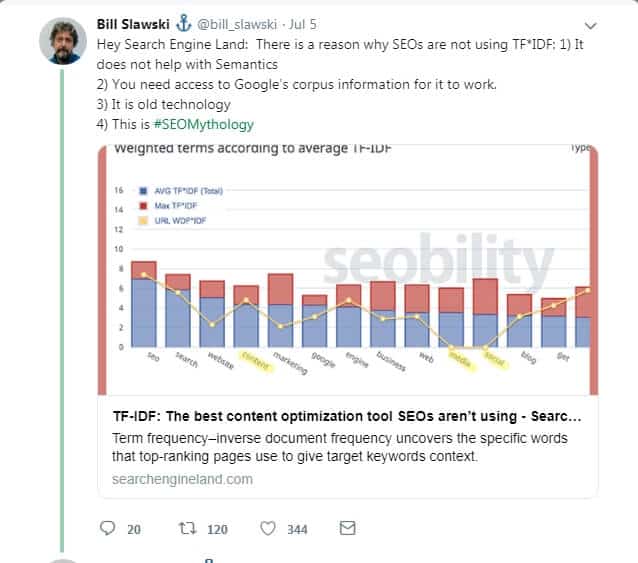
Hi Nik, good to see you on Arfa’s space here. 🙂
You did a wonderful job with this guide. Indeed you covered almost everything about affiliate site and the healthy SEO strategies to rank well in search.
The 3 components you explained it well thru these page with relevant images and screenshots.
Keep writing.
I am bookmarking it for my further reference and application.
Thank Arfa for making this happen on these pages.
wish you both a great time of sharing and caring ahead.
Thank you so much for the kind shout out my prestigious post on blog commenting “The Power of Blog Commenting” in the section Bonus #3- Link Pillowing, yay or nay?
I appreciate the mention.
Keep sharing.
Best Regards
~ Philip
Hi Arfa,
thanks again for featuring me on your awesome blog. It’s an honor and a privilege and I hope that folks that stumble upon this post find lots of value here.
As there sure is some, and some more:)
Cheers!
Hi Phil,
thanks for your awesome comment.
You deserve the mention as it is the post I peruse often.
It’s packed with value.
Cheers!
Hello Arfa and Nikola,
This is a great and detailed piece of information. Affiliate Marketing is one of the best ways to make money online. However, Ranking an affiliate site is a tricky part. You have to add value to your reviews that you write for your posts. Google loves sites that have quality content. Otherwise, they will penalize it saying thin affiliate content. Thanks for sharing the helpful tips here.
Regards,
Vishwajeet
Nikola, thanks for the shout out bro 🙂 Fabulous guide. The devil is in details, affiliate-wise. Ranking a new site takes careful, deliberate planning and acting, as does blogging or most anything online. Thoughtful bloggers succeed.
Hi Nikola,
This type of post is what I call an ultimate guide. Yes, it is. Ranking a new site is not an easy fit, not to mention the intense competition that is associated with digital marketing. And with affiliate marketing being a major money making tactics for several bloggers, it is critical to master the best tips to rank your site, which you presented here. Nonetheless you made it seem a lot easier with examples and screenshots.
Thanks Moss!
Nothing beat a solid plan followed by consistent action until results start to appear.
After that it’s easy to push on as you see everything you do has an effect.
So true Ryan.
It is possible to succeed nowadays, but you need to have a plan to do it. It’s not enough to throw spaghetti on the wall hoping something will stick.
That approach used to work when Google didn’t have enough content to work with.
Now they do and we need to adapt.
Wow, this is a fantastic piece Arfa.
Great tips here 🙂
Ranking an affiliate site is not being easier, where the competition is on its peak. Although, as said not impossible at all with proper strategy.
A great piece always deserves to be at the top. Of course great content is not the only thing. Social Signals and powerful backlinks always have that sweet spot in Google Ranking factors, even if they don’t reveal it.
Have a great day!
Navin
Hi Navin, thanks for stopping by to comment.
Yes, content/strong backlinks combo rules Google and even Bing/Yahoo.
It’s had to beat a great article that has awesome links pointing to it, and a bunch of social shares/social proof to boot.
Awesome post Nikola. Too much value in this. Thanks for putting in the work.
This is a full SEO course in one page. I’m bookmarking this. ?
Thanks for the shout out too.
Hey Arfa and Nikola,
This has been a real eye opener.
Don’t really read long articles but I stuck to my phone for this one and I loved it. Great article.
Will add these points to my my knowledge on SEO for my blog.
Thank you. Both of you.
Glad you enjoyed reading, Vince!
Thank you for interviewing me way back when I was just starting out and felt like fish on dry land.
Interview with you boosted my self confined like buckets of water revive fish out of their natural element.
Let’s all keep swimming:)
I’m glad it helped. It’s been a while but I’m restarting the series this week.
Let’s keep swimming. 🙂
Hi Nikola and Arfa, wow, great tips here! So many things to be done today for SEO, on site and off site. Ranking for an affiliate is not easy with all the competition today too. I love how you do the intro “chapters”. Is that via a plugin? I’ve been seeing more and more of these for blog posts. Thanks for the mention and glad to see you are getting the backlinks 🙂 Have a great weekend ahead!
Hi Lisa,
yeah, that’s done with a content table plugin. Very useful stuff.
Thanks for stopping by and commenting, glad you liked the post. You’re right, ranking an affiliate site is not easy, and ranking a new one is hard. But, that’s the challenge and it can be done:)
Hey Lisa,
It’s so good to have you on the blog. I agree, there is a long list of things to do for on-page and off-page SEO to rank a new website on google. Nikola did a brilliant job by writing this in-depth guide. Oh, yeah, I use a plugin called ‘Easy Table Of Contents’. It’s great.
Hi Jemila,
thanks for you comment. Just from reading it I can tell you really enjoyed it. Glad you learned something new and remember, SEO is complex and there’s so much to do and learn.
Take it slow, master one thing after the other and push forward. White hat SEO works; works long term and can make your blog a successful business so you can be independent of the 9-5 grind. That’s the dream, for all of us, right?
Take care, Jemila:)
So many great tips here! SEO is a tricky thing for a lot of bloggers, myself included, but so important! I had no idea about many of these tricks and I’ll definitely be referring back to this post often.
Hi Mariam,
I used to think the same when I started out! But, yeah, thanks to Nikola for writing such an awesome guide that explains everything in so detail.
Hello Nikola
That’s an awesome blog post on this blog… Actually it’s my first time on this blog; I jumped in through a comment I saw on another blog.
I’ve learnt what it takes to get Google to index my new Affiliate site..
I started one recently and am currently building it.
Thanks a lot.
Hi Joseph,
good for you for starting a new blog. Remember to take it slow at first; to learn a lot, do a lot and keep going forward. If you don’t give up but hack at it everyday, you will get the results you want.
It’s a guarantee…
Hi Arfa,
Thanks for amazing blog post. this blog post is full of valuable information. I have thoroughly enjoyed reading this blog post. I have recently started blogging and i am going to use your tips to boost traffic for my blog.
Like you even I have totally ignored twitter marketing. after reading your blog i feel i need start using twitter for marketing. I am also going to try Guest blogging. I have heard a lot about Guest blogging, I hope Guest blogging will bring good amount of traffic for my website.
Love this guide, amazing share. I wondered if you used semrush. Is it any better than jaaxy/kwfinder? Thanks!
Hi Arfa, Affiliate websites are without a doubt a great way to make money online. Many newbie bloggers start their journey into the affiliate marketing without the knowledge of how to rank their website and generate high quality traffic. Understanding how to make your new affiliate website a successful one is the key to generating considerable amount of money affiliate website.
To add to what you are saying in this blog post. I would like to say that it is important that newbie use a good hosting service for their website. One mistake i see newbies make when they start their affiliate marketing websites is that they do not focus on implementing newsletters. They should collect emails of the visitors of their website as early as possible and they start engaging with them through emails.
Arfa, I am so glad that I found your content. The information you provide is helping me sort through this absolute maze of blogging. I have pinned many articles to refer to when I have a question because your answers are so easy to understand and so complete. Thank you so very much for sharing your knowledge with the world!!! And me:)
Thank you, thank you, thank you!! Finally an awesome guide on how SEO should really work with having a newer website. Such great content! Can’t wait to implement all of your advice!!
Arfa is awesome Maria;
I often find myself going back to her site for inspiration. She’s obviously a successful blogger; so why try and reinvent the wheel when you can just copy what works for the pros and then add your unique twist to it.
And if you’re stuck in the maze of blogging, the best way to stay put, and then advance till the exit is to create evergreen content that will continue to help you ten years from now.
Arfa can help you there:
https://shemeansblogging.com/create-convert-content/
So true Niharika,
good hosting is crucial to keep site load speeds down, and visitors happy.
As for newsletters, ideally you need to have optins from day one. But the world is not an ideal place and I find it’s often best that when you start and have zero traffic, you work on getting that traffic, rather than setting up forms no one will see for a long time.
Excellent Michelle. Thank you for your kind words and implementation is key.
Even bad SEO is 100 times better than just sitting on the chair and thinking about doing SEO.
Do and you will learn in the process.
Hey,
This is an insane post on how to rank an affiliate site. Its true that ranking an affiliate site is getting harder day by day but I believe content is the king and if you can write good SEO friendly content, you will have the ball in your court.
Thanks for this awesome post.
Hi Rajiv,
yeah content is key and links are almost secondary. I say that because you will most definitely need links to rank high for anything even remotely competitive.
But with great content you will need only a few of them to climb to the top.
And with awful content, then even a 1000 backlinks can’t put a dent in rankings.
Just be careful putting your keyword in the alt tags if it doesn’t describe the image. Alt tags are to help visually impaired people – not to boost SEO. I get that it can help rankings, but it’s kind of manipulative and if you don’t use things like alt tags in the way google wants you to use them, you can get flagged by Google’s human testers or hit badly by algorithm updates.
Hi Nikola
You have touched on some important concepts of SEO and Affiliate marketing. Site structure is one thing that defines the present and future plans of a blog and if someone is starting out it should not be ignored. Recently I was discussing this concept with a blogger and the conclusion was a clean site structure and user experience are 2 things that differentiates the best from the good.
All in all an amazing post. A knowledge bomb everyone should read.
Thank You
Jasmeet
Hi Arfa,
Thanks for this detailed post but I wonder If there is any free tool to do keyword research with more accurate results so that beginners like me can explore more without risking more dollars.
This was incredibly helpful for someone just starting out and learning the ins and outs of a new blog. Thank you!
I’m happy to read that! I’m sure you have found this post helpful.
Hello Nikola,
Great and detailed piece of information. Affiliate Marketing is the best way to generate passive revenue. Ranking of such sites depends on authority and user reviews because Google loves to ranks authoritative sites.
Regards,
Deepak
Found this article via Pinterest.
Very well written article Arfa.
I have used KWFINDER, and Google auto-suggest in the past to find keywords, but I have never tried Jaaxy before. Thank You for this tip.
Have you ever tried using, Answer The Public?
If so, what do you think of that website?
R.G. Ramsey
Nikola, your article is absolutely extraordinary!!!! Full of detail and with plenty of examples!
I thought for a while I was writing blogs that are maybe too long… and I then found you! ????
Your blog goes well beyond the usual suspects in seo advice, which makes it fascinating!
I am also loving Arfa’s site and FB group. Truly a life saver!
Thanks to both for your leadership! ????????????????
Phew! Quite a lengthy blog but I really enjoyed reading it. Keep sharing the awesome content about blogging.
I am gonna save this information. however, I have a question that I am just at a beginner level and currently doing Off-page SEO as a practice. Using different tactics like link-building, guest posting, business posting, etc. Now as per my knowledge your Domain authority increases with the quality backlinks but does it also depend upon other types like On-page SEO and site structure. If yes, then if I continue to practice mentioned above, then how much time will it take to get ranked on google.Because I have been reading about this and most of them say that link building is the way to get higher domain authority
This is a great article and exactly what I needed to help me in my new blogging adventure! Thanks so much!